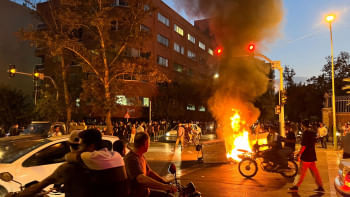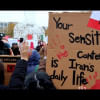The futility of oppression in Iran

Sometime between June and July of 1848, at a conference in the city of Bedasht, in the Semnan Province of Iran, a Babi poet and revolutionary named Fatimih Baraghani Tahirih dared to appear unveiled in front of 80 men. Tahirih lived during the Qajar Dynasty, when women were ignorant, illiterate, and kept hidden from the public gaze – a milieu marked by totalitarianism, dogmatism, and unquestionable patriarchy in its most severe forms. Tahirih's intellectual abilities, eloquence, poetic talents, insatiable curiosity, and unwavering courage made her one of the rarest women of her time – a result of the wishes of her father (an Islamic scholar of Qazvin) to educate his beloved daughter within the confines of his own library.
Tahirih's audacity to do the unthinkable – her fearless action of presenting herself to her male companions without her veil – may have been a rude awakening for many who were unwilling to accept their female counterparts as their equals.
It must be understood that the act of unveiling was not to disrespect or go against any religious tenet; rather, it was a bold move that symbolised equality of the sexes and was used to make a statement that women can act independently and make their own choices. Perhaps the first women's rights activist in Persia, Tahirih was executed by strangulation for her radical beliefs and resolute convictions. Her prophetic final words were, "You can kill me as soon as you like, but you can never stop the emancipation of women."
Interestingly, exactly 100 years after the audacious unveiling of Tahirih in Bedasht, the United Nations gathered in Paris in 1948 and composed the new Universal Declaration of Human Rights, which states: "All human beings are born free and equal in dignity and rights."

And 174 years later, in 2022, under the Islamic regime of Iran that has imposed multiple oppressive laws, thousands of women have taken to the streets in the nation that gave birth to the lion-hearted Tahirih. It's almost as if Tahirih's fiery spirit has been rekindled in the hearts of the repressed Iranian women today. And despite knowing that they may be arrested, beaten, or killed the way 22-year-old Mahsa Amini was killed at the hands of the notorious Morality Police on September 16 for wearing the hijab "improperly," they are protesting valiantly.
They chant powerful slogans, the rhythm of which can electrify your soul, especially if you speak Farsi like I do, "Natarsin, natarsin! Ma haameh bahaam hastim! (Do not fear, do not fear! We are in this together!)," or "Zan, zendegi, azadi! (Women, life, freedom!)." Some even sound like war slogans, "Mikosham, mikosham, har aankeh khaharam kosht! (I will kill, I will kill, the one who has killed my sister!)."
Many Iranian women are cutting their hair on social media as well as in public, and while doing so, they say, "Baraaye azadi! (For freedom!)." Videos of the violent nationwide protests sparked by Mahsa Amini's murder also show women burning their hijabs on the streets – a compulsory garment for women in Iran. Perhaps the best part of seeing these demonstrations is that there are possibly an equal number of men standing alongside women, fighting for their rights.
Iranian-British actor and comedian, Omid Jalili, called this moment in history a "George Floyd moment," hoping that the protests will lead to something bigger, to bring about change in the gender-apartheid state. Masih Alinejad, an Iranian-American journalist, has been posting tweets about Mahsa and the repercussions of her murder continuously, one of which states, "This is the brutality of [the] Islamic Republic of Iran that has a seat at [the] UN to monitor women's rights globally."

Iran's Interior Minister Ahmad Vahidi has shamelessly claimed that Mahsa had pre-existing medical conditions, which her family has denied, and medical tests confirm skull fractures and internal bleeding in the brain. The lies seem to be pouring. President Ebrahim Raisi claimed that women in Iran wore the hijab as a voluntary act and that no one had compelled them to do so; rather, they regard themselves as committed to the issue. In order to mute people and their voices, Iran has restricted access to WhatsApp and Instagram as the protests are growing larger and spreading like wildfire.
The fearless demonstrations that have led to violent beatings at the hands of the police and eight deaths so far may be the beginning of a revolution, but they are not the first of their kind. "The Girls of Enghelab Street" was a series of protests against the compulsory hijab in Iran that was started by Vida Movahed in 2017, who tied her white hijab at the end of a stick and waved it, much like waving a white flag that symbolises peace, while standing on a utility box in a crowded street.
It seems that this dictatorial, tyrannical regime's inhumane methods, employed to snuff out protests calling for freedom of choice, are no longer working. Iranian women are willing to die to be free – free to choose to wear the hijab and free to choose not to. As a Bangladeshi female citizen who is Iranian by race, I condemn those who persecute women in the name of religion, and I vow solidarity with those protesting against the murder of #MahsaAmini.
Noora Shamsi Bahar is a writer and translator, and a senior lecturer at the Department of English and Modern Languages in North South University (NSU).

 For all latest news, follow The Daily Star's Google News channel.
For all latest news, follow The Daily Star's Google News channel. 










Comments